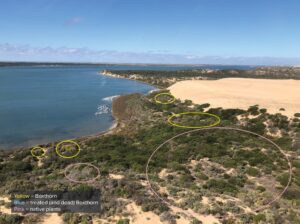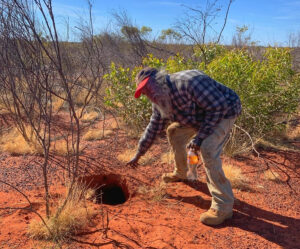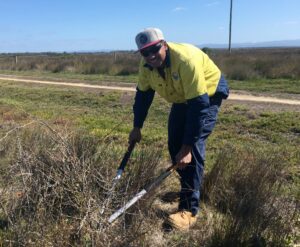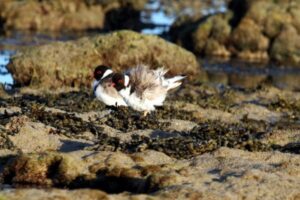National NRM update for August 2020. This update represents just a handful among the hundreds of NRM projects going on across Australia, which are made possible through funding from the Australian Government’s National Landcare Program and from respective State governments.

Completed on-ground river rehabilitation works in the Pipers catchment, Lilydale.
NRM North's Partnerships for Giant Freshwater Lobster Recovery project has delivered its first milestone target, which has seen 5 kms of high priority river reaches protected and rehabilitated in north-eastern Tasmania. Landholders are seeing positive results from revegetating riverbanks with native species to increase stream shading, providing off-stream stock water sources, undertaking riverbank weed control and fencing stock out of waterways. This reduces waterway disturbance and erosion, enabling habitat extension and protection within high priority river reaches.
 South West Catchments Council (SWCC) has released a report on the key drivers, as well as barriers and risks, of the uptake of regenerative agriculture practices by farmers in Western Australia. The report recommends a series of actions that, if applied, may assist farmers in their decision-making process when implementing regenerative practices on their properties.
South West Catchments Council (SWCC) has released a report on the key drivers, as well as barriers and risks, of the uptake of regenerative agriculture practices by farmers in Western Australia. The report recommends a series of actions that, if applied, may assist farmers in their decision-making process when implementing regenerative practices on their properties.
The WA State NRM Program funded report was part of a project led by SWCC, with contribution from WA’s six other NRM regions. For more information and a link to the report, click here.
 In SA, the Limestone Coast Landscape Board's Our Coorong|Our Coast project is working to improve the ecological character of the Coorong and enhance habitat for threatened species along the Limestone Coast. Species such as the Hooded Plover, Orange-bellied Parrot, Eastern Curlew, Malleefowl and other migratory shorebirds rely on this habitat which is under threat from a number of issues. Recent project activities have been working to control African boxthorn infestations, which can blend and tangle in with native vegetation, making control a challenging task. For more information on the project, visit the LCLB website.
In SA, the Limestone Coast Landscape Board's Our Coorong|Our Coast project is working to improve the ecological character of the Coorong and enhance habitat for threatened species along the Limestone Coast. Species such as the Hooded Plover, Orange-bellied Parrot, Eastern Curlew, Malleefowl and other migratory shorebirds rely on this habitat which is under threat from a number of issues. Recent project activities have been working to control African boxthorn infestations, which can blend and tangle in with native vegetation, making control a challenging task. For more information on the project, visit the LCLB website.
 This video from Victoria's East Gippsland CMA is a great summary of the outcomes that have been achieved in the Mitchell Creek over the last 15 years by EGCMA in their efforts to remove willows and help restore the natural riparian ecosystems of this region.
This video from Victoria's East Gippsland CMA is a great summary of the outcomes that have been achieved in the Mitchell Creek over the last 15 years by EGCMA in their efforts to remove willows and help restore the natural riparian ecosystems of this region.
 Healthy soil is critical to a productive enterprise. North Queensland Dry Topics NRM have produced a series of seven videos presented by soil expert David Hardwick of Soil Land Food. The videos focus on the different elements that contribute to soil health, and how to test them.
Healthy soil is critical to a productive enterprise. North Queensland Dry Topics NRM have produced a series of seven videos presented by soil expert David Hardwick of Soil Land Food. The videos focus on the different elements that contribute to soil health, and how to test them.

Benedict “Mosquito”, pointing at a bilby burrow. Burrows can be identified by their distinctive round shape and bilbies may dig many burrows across their home range.
In the NT, Territory NRM is working in collaboration with Indigenous ranger groups and Traditional Owners in central Australia to survey for bilbies and help manage threats to the species. Staff from TNRM recently visited Pirti Pirti in the Southern Tanami IPA with Traditional Owners, Warlpiri rangers and North Tanami rangers. The aim of the trip was to conduct bilby surveys in areas that have not been visited recently and to identify potential new sites. Bilby presence was identified in several locations where they had not been recorded for decades, and data obtained from this fieldwork will be used to protect the habitat of the greater bilby in the Northern Territory.

Image credit: Central Tablelands LLS
The endangered Blue Mountains Water Skink (Eulamprus leuraensis) is in serious trouble, according to the latest report by the 'Swamped by Threats' project. The swamp-dependent skink is found only in the Blue Mountains region, and recorded numbers at a key habitat site have dropped to zero in the latest monitoring survey conducted earlier this year. While the recent findings of zero skinks at the Carne West site are concerning, the 'Swamped by Threats' team are doing their best to protect habitat where possible. Central Tablelands Local Lands Services is the lead agency in this project, working with stakeholders, community groups and partners including the Biodiversity and Conservation Division of the Department of Planning, Industry and Environment. For more information, visit the NSW LLS news page.

Image credit: West Gippsland CMA
After nearly ten successful years working to protect and enhance saltmarsh habitat at Corner Inlet in Victoria, the West Gippsland Catchment Management Authority’s Coastal Saltmarsh Protection Program is expanding to work with new landholders and more closely with partner agencies. NLP funding will see more collaboration between the WGCMA team and partner agencies such as Trust for Nature and the Gunaikurnai Land and Waters Aboriginal Corporation. During the next three years Trust for Nature aims to work with landholders to covenant and control high-threat weeds across 80ha of saltmarsh habitat. This will more than double the area of permanently protected saltmarsh habitats on private land within Corner Inlet. For more information, visit the WGCMA website.
 Southern Queensland Landscapes recently worked with Craig Hunter from Biosecurity Queensland on the removal of small infestations of giant rats tail grass. While the weed is uncommon in the region, it poses a threat to natural grasslands and productive agricultural lands. For land managers, it is important to know what to look for to have ample opportunity to eradicate the weed early and avoid long-term infestations and damage to landscapes. SQ Landscapes produced this video to show landholders what to look out for.
Southern Queensland Landscapes recently worked with Craig Hunter from Biosecurity Queensland on the removal of small infestations of giant rats tail grass. While the weed is uncommon in the region, it poses a threat to natural grasslands and productive agricultural lands. For land managers, it is important to know what to look for to have ample opportunity to eradicate the weed early and avoid long-term infestations and damage to landscapes. SQ Landscapes produced this video to show landholders what to look out for.

Image Credit: Eyre Peninsula Landscape Board
Monitoring at Hooded Plover beach nesting territories on the Eyre Peninsula has begun. This monitoring, which is being carried out by Eyre Peninsula Landscape Board staff and volunteers, is essential to increasing the chances of survival of this threatened species. The data gathered helps scientists understand the threats impacting on breeding success and then implement threat abatement activities. This is the second year of monitoring under the Saltmarsh Threat Abatement and Recovery Project, funded through the National Landcare Program. Click here for more information.
These entries for this year's Threatened Species Bake Off take the cake! Organised through the Threatened Species Commissioner to coincide with Threatened Species Day on September 7, this annual event showcases not only a wonderful showcase of imagination and culinary skills from across our nation but serves to highlight the plight of our threatened species. Check out some of the great entries below - and to see more, head to the Threatened Species Commissioner's facebook album.










